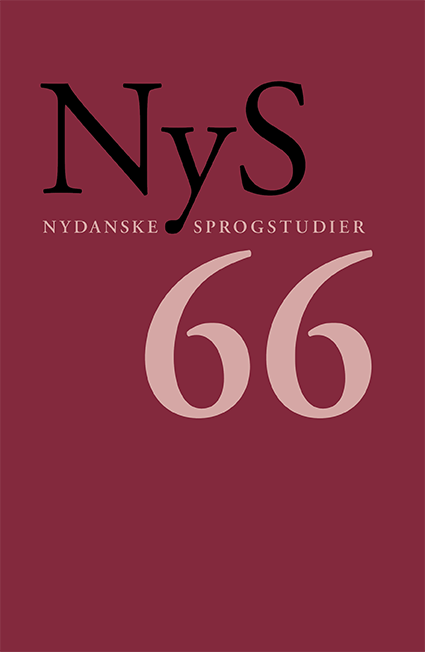Sin and deres with plural antecedents in KorpusDK
DOI:
https://doi.org/10.7146/nys.v1i66.146748Keywords:
possessive reflexives, KorpusDK, animacy, number, distributivityAbstract
The Danish possessive reflexive sin (sit, sine) has primarily been used with singular antecedents for at least 800 years. A speaker may say that She took sin hat and left but Karen and Per drove home in sin their car. The non-reflexive third person plural possessive deres is usually used instead of sin when the subject antecedent is plural. It is, however, not uncommon to find sin used with plural antecedents in modern Danish, also in more formal contexts. In this study, I investigate the occurrence of sin with plural antecedents in KorpusDK and almost every example of sin with plural antecedents in KorpusDK is included in the study. The study finds that sin does occur with plural antecedents in the reasonably formal written corpus, although deres is still the most frequent form. I compare the use of sin with plural antecedents with the standard forms, deres with plural antecedents and sin with all kinds of antecedents. The use of sin with plural antecedents is clearly different from the standard forms along various syntactic and semantic parameters. I conclude that sin with plural antecedents is a systematically conditioned variant in the corpus and not "just" an agreement error.
References
Bibelen i autoriseret oversættelse. 1992. København: Det Danske Bibelselskab.
Chomsky, N. 1981. Lectures on Government and Binding. Dordrecht: Foris. DOI: https://doi.org/10.1515/9783110884166.
Chr. III’s Bibel fra Tekster fra Danmarks middelalder og renæssance 1100-1550, https://tekstnet.dk/ (tilgået 16. december 2019).
Diderichsen, P. 1939. Om Pronomenerne sig og sin. Acta philologica Scandinavica 13. 1–95.
Ehlers, K.R. 2024. Number-sensitive reflexive pronouns in Danish: Optionality, microvariation, and cyclic change. Ph.d.-afhandling. Aarhus Universitet.
Ehlers, K.R. 2020. Sin og sig med flertalsantecedent fra runesten til LANCHART. Danske Studier. 48–84. DOI: https://doi.org/10.7146/danskestudier.vi.128795.
Ehlers, K.R. & S. Vikner. 2017. De to slags betingelser i det danske refleksivsystem – hvorfor det er svært både at skælde sig ud og at skille sig selv ud. I.S. Hansen, T.T. Hougaard & K.T. Petersen. 16. Møde om Udforskningen af Dansk Sprog (MUDS 16), 91–120. Aarhus: Aarhus Universitet.
Falk, A. & H. Torp. 1900. Dansk-norskens syntax i historisk fremstilling. Kristiania: Aschehoug.
Hansen, A. 1965. Vort vanskelige sprog, 2. udg. København: Grafisk forlag.
Hansen, E. 1993. Rigtigt dansk. København: Hans Reitzel.
Hagedorn, K.T. & H. Jørgensen. 2009. The status of the pronoun sin in Western Jutland. Manuskript. Aarhus Universitet.
Jensen, T.J. 2009. Refleksivt anvendte pronomener i moderne dansk. Ny Forskning i Grammatik 16. 131–51. DOI: https://doi.org/10.7146/nfg.v17i16.23735.
Larrivée, P. & A. Kallel. 2020. The empirical reality of bridging contexts: strong polarity contexts as the transition between NPIs and n-Words. Journal of Historical Linguistics 10(3). 427–51. DOI: https://doi.org/10.1075/jhl.00010.lar.
Lundquist, B. 2014. Number sensitive anaphors and short distance pronouns. Nordic Atlas of Language Structures Journal 1 (1). DOI: https://doi.org/10.5617/nals.5423.
Lødrup, H. 2009. Animacy and long distance binding in Norwegian. Nordic Journal of Linguistics 32(1): 111–36. DOI: https://doi.org/10.1017/S0332586509002054.
Mikkelsen, K. 1911. Dansk ordføjningslære med sproghistoriske tillæg: Håndbog for viderekomne og lærere. København: Lehmann & Stage.
Miltersen, E. H. (2018). De, den, hen, and the rest: A pilot study of the use of gender- neutral and nonbinary/genderqueer pronouns in Danish. Journal of Language Works – Sprogvidenskabeligt Studentertidsskrift 3(1): 31–42. https://tidsskrift.dk/lwo/article/view/107538.
Nevins, A. & P. Weisser. 2019. Closest conjunct agreement. Annual Review of Linguistics 5. 219–241. DOI: https://doi.org/10.1146/annurev-linguistics-011718-012708.
Nguyen, M. 2024. Var det sin eller hans kone Jens kyssede? Refleksiv reference i sætningskløvning og pseudokløvning. Ny Forskning i Grammatik 31: 108–125. DOI: https://doi.org/10.7146/nfg.v1i31.145296.
Python Software Foundation. 2016. Python (3.5.2). https://www.python.org/downloads/release/python-352/.
R Core Team. 2021. R: A language and environment for statistical computing. Vienna, Austria: R Foundation for Statistical Computing. https://www.R-project.org.
Rask. R. 1820. “Den danske Grammatiks Endelser og Former af det islandske Sprog forklarede. Et Forsög af Prof. R. Rask.” Det Skandinaviske Litteraturselskabs Skrifter 17. 75–150.
Reuland, E. & P. Zubkov. 2022. Agreeing to bind: the case of Russian. Glossa: a journal of general linguistics 7(1). 1–32. DOI: https://doi.org/10.16995/glossa.5730.
Vikner, S. 1991. Relative der and other C0 elements in Danish. Lingua 84 (2–3): 109– 136. DOI: https://doi.org/10.1016/0024-3841(91)90067-F.
Vikner, S. 1999. Ledstillingen i dansk og government & binding. Per Anker Jensen & Peter Skadhauge (red.), Sætningsskemaet i generativ lingvistik. Kolding: Institut for Erhvervssproglig Informatik og Kommunikation, Syddansk Universitet. 83–110. https://tildeweb.au.dk/au132769/papers/vikn99a.pdf.
Vikner, S. & K.R. Ehlers. 2017. Sin, hendes og KorpusDK. Ny forskning i grammatik 24. 175–194. DOI: https://doi.org/10.7146/nfg.v25i24.97252.
Tang, C. J. 1989. Chinese reflexives. Natural Language Linguistic Theory 7(1): 93–121. DOI: https://doi.org/10.1007/BF00141348.
Downloads
Published
How to Cite
Issue
Section
License
Forfatteren/forfatterne og NyS har ophavsret til de artikler og anmeldelser der bringes i tidsskriftet. NyS har ophavsretten til den udgivne version af tidsskriftet. Forfatteren har ophavsretten til sin egen tekst. Forfattere kan arkivere den publicerede artikel på deres institutions forskningsarkiv (Institutional Repository) eller en privat hjemmeside, når forfatteren samtidig linker til artiklen med den officielle DOI.
For artikler publiceret i NyS tillades at læsere kan downloade, kopiere, udskrive, søge eller linke til og citere fra artikler til ethvert lovligt formål. Artikler kan frit deles og linkes til på forsknings- og undervisningsnetværk (så som Blackboard, Moodle, Canvas o.a.). Link foretrækkes fordi det giver oplysning om brug af tidsskriftets artikler, og fordi det anerkender tidsskriftets redaktionelle arbejde. NyS tillader ikke at læsere bruger artikler eller dele af dem i egne artikler uden at citere, eller at læsere på anden vis anvender dem til kommercielle formål.





